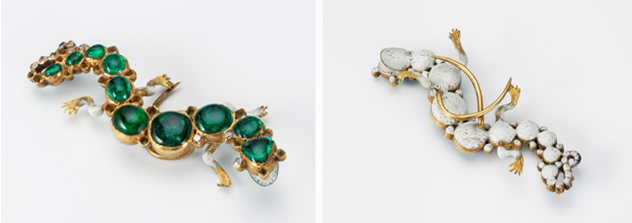A treasure trove of jewels that lay hidden underground for nearly 300 years is now on display at the Museum of London. Nearly a century after its discovery, the entire collection is being exhibited together for the first time. Workers demolishing a tenement house in the Cheapside district of London in 1912 discovered the priceless Elizabethan and Jacobean jewelry, loose gems and objects buried in a cellar. The treasure became known as “The Cheapside Hoard,” but the identity of its owner remains an enigma.
“The Cheapside Hoard tells a thrilling tale of mystery and discovery, with every jewel and gemstone unlocking a story,” said Sharon Ament, Museum of London Director. “It has a lot more to tell the world than simply the look and feel of the jewels themselves.”
The undisturbed, subterranean resting place kept most items from the Cheapside Hoard well-preserved, like this pomander, or scent bottle, that once hung from a chain. This golden jewel is set with carved chalcedony leaves, rubies, pink sapphires and diamonds, and decorated with white enamel.
This salamander brooch contains cabochon Colombian emeralds and table-cut diamonds from India. The origin of the gemstones in this iconic piece provides historical insight into the international gem trade during the late 1500s and early 1600s. The underside of the brooch depicts the sophisticated enameling skills as well as the complex curved pins designed to keep the jewel in place.
Due to its exquisite workmanship, this one-of-a-kind pocket watch in a massive, polished hexagonal Colombian emerald, was likely designed for nobility. Its gold dial with green enamel is visible through the hinged cover created from a thin slice of the emerald crystal.
We’ll be covering the exhibit in detail in an upcoming post, so be sure to subscribe to the feed for updates. In the meantime, for an expanded “behind-the-scenes” look at the Cheapside Hoard exhibition with exclusive video footage, visit GIA’s Fall 2013 issue of Gems & Gemology.
Main Image: A rose-cut sapphire and diamond cross pendant. Courtesy of the Museum of London; photos by Robert Weldon/GIA.



